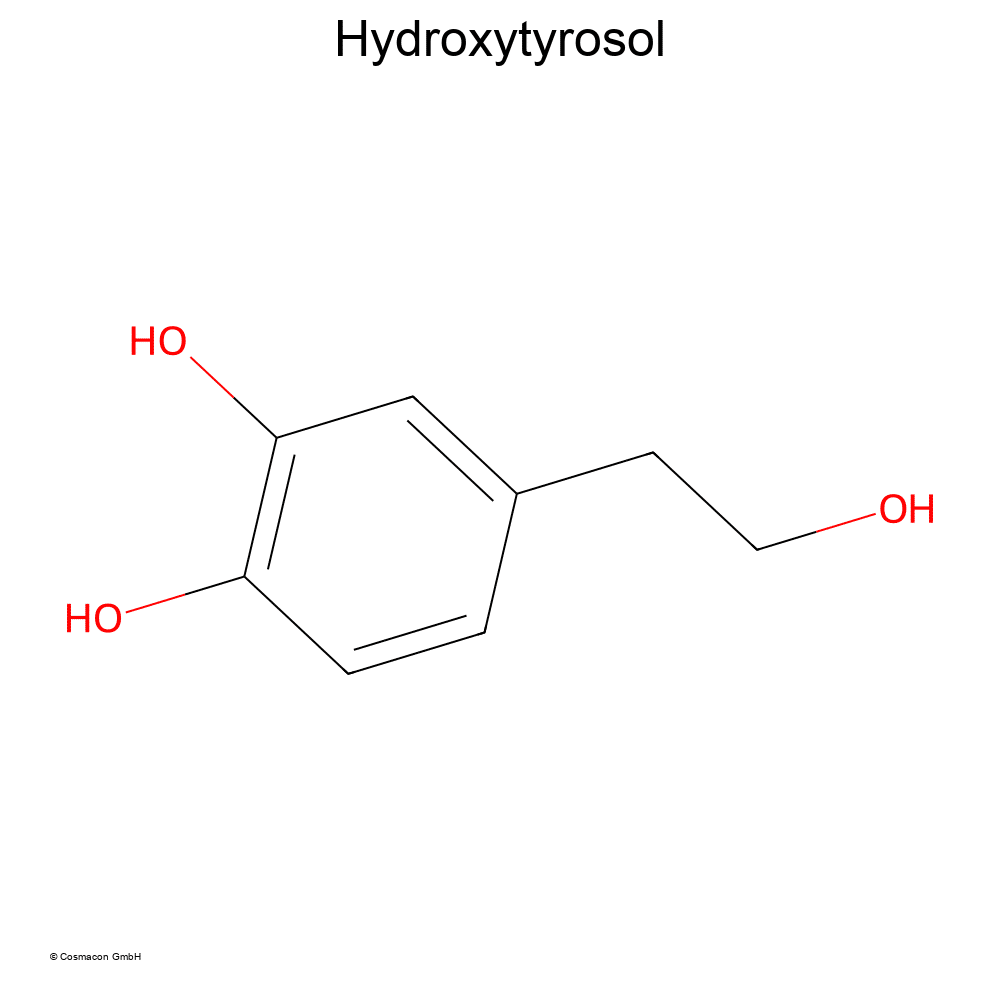Hydroxytyrosol is an outstanding natural ingredient that is attracting increasing attention in the cosmetics industry. As one of the most powerful antioxidants known, it offers a wide range of benefits for skin care, from antioxidant protection and anti-inflammatory effects to anti-aging properties. This article highlights the physical and chemical properties, effectiveness, application possibilities, and potential challenges of this active ingredient. We also present specific product ideas and provide an outlook on how Tojo Cosmetics can support your brand with this innovative active ingredient.
What is hydroxytyrosol?
Hydroxytyrosol is a polyphenolic secondary plant compound that is mainly extracted from olives (Olea europaea). It is a derivative of tyrosol and belongs to the phenol class. The compound is water-soluble, highly antioxidant, and has high bioavailability. These properties make hydroxytyrosol an ideal candidate for use in modern skin care products.
Physicochemical characteristics of hydroxytyrosol
The chemical and physical properties of hydroxytyrosol are crucial for its use in cosmetic formulations. Here is an overview of the most important data:
INCI name: Hydroxytyrosol
CAS No.: 10597-60-1
EINECS No.: 600-704-3
Molecular formula: C₈H₁₀O₃
Molecular weight: 154.16 g/mol
Appearance: Colorless to slightly yellowish, viscous liquid or whitish powder
Purity (HPLC): ≥ 99% (viscous liquid), ≥ 20% (powder with maltodextrin)
Solubility: Water soluble
Loss on drying: ≤ 2-5%
Heavy metals: Pb ≤ 10 ppm, As ≤ 2 ppm, Hg ≤ 1 ppm, Cd ≤ 5 ppm
Storage: 2–8 °C (liquid form), dry and protected from light
These parameters ensure stability and safety in cosmetic applications and facilitate integration into water-based formulations.
Cosmetic effects and scientific findings
Hydroxytyrosol has a wide range of skin-relevant mechanisms of action:
- Antioxidant effect:neutralization of free radicals, protection against oxidative stress
- Anti-inflammatory:soothing of irritated, reddened or inflamed skin
- Moisturizing:supports the barrier function and helps keep the skin hydrated
- Anti-aging:promotes collagen synthesis and reduces wrinkles and fine lines
- Brightening:mild brightening effect through regulation of melanin production
- Cell regeneration:accelerates the regeneration of damaged skin cells
Effectiveness and recommended concentrations
In vitro studies and cosmetic formulation tests show that hydroxytyrosol can exhibit antioxidant and anti-inflammatory effects in concentrations as low as 0.1%. For clearly visible anti-aging effects, a concentration of between 1 and 3% is recommended. In cosmetic formulations, the active ingredient can be used in a dosage of 0.1–5.0%.
Advantages of hydroxytyrosol
Its many positive properties make hydroxytyrosol a particularly attractive active ingredient in modern dermocosmetics.
- Very powerful antioxidant:More effective than vitamins C and E at neutralizing free radicals
- Broad spectrum of activity:Antioxidant, anti-inflammatory, regenerative
- Good skin tolerance:Also suitable for sensitive skin
- Synergistic use:Can be combined with other active ingredients such as niacinamide or hyaluronic acid
- Water-soluble:Easy to formulate in emulsions, gels, and serums
Disadvantages and challenges
Despite its many advantages, hydroxytyrosol also has some limitations that should be taken into account during product development:
- Sensitivity to light and oxygen:Requires suitable packaging (e.g., airless dispensers, light protection)
- Moisture sensitivity:Hydroxytyrosol can be hygroscopic, especially in powder form.
- Relatively high cost:Due to its complex extraction process and high purity, it is not the cheapest active ingredient.
- Colouring:In higher concentrations, the formulation may take on a slight yellow colour.
Application ideas in cosmetic products
Hydroxytyrosol is very versatile. Below are some ideas for products in which this active ingredient is particularly effective:
- Antioxidant serum:
Light, water-based serum with 2% hydroxytyrosol, hyaluronic acid, and panthenol for urban skin protection. - Soothing day cream:
Emulsion with 1% hydroxytyrosol, bisabolol, and ceramides to reduce redness. - Anti-aging night cream:
Rich cream with 3% hydroxytyrosol, retinol (0.2%), and vitamin E for overnight regeneration. - Eye gel:
Light gel with 0.5% hydroxytyrosol and peptides to combat fine lines and dark circles around the eyes. - After-sun lotion:
Moisturizing lotion with 1% hydroxytyrosol to soothe the skin after UV exposure. - Body lotion for sensitive skin:
Large-area care with 0.5–1% hydroxytyrosol for skin prone to neurodermatitis.
Summary and outlook
Hydroxytyrosol is an innovative active ingredient with enormous potential for cosmetic applications. Its outstanding antioxidant power, combined with anti-inflammatory and regenerative properties, makes it an ideal ingredient for modern skin care products. Especially in times of “clean beauty” and functional cosmetics, hydroxytyrosol is increasingly valued as a natural, highly effective ingredient.
Despite some formulation challenges, the benefits of this polyphenol clearly outweigh any drawbacks. For brands looking for highly functional, natural, and scientifically proven active ingredients, hydroxytyrosol is an excellent choice.
We use the active ingredient hydroxytyrosol, which meets the highest standards of efficacy, skin compatibility, and innovation, in our high-quality private label products. We combine proven ingredients with modern biotechnological developments to create tailor-made formulations that meet the individual needs of your target group. Our focus is on quality, transparency, and the optimal synergy of all ingredients—for visible results and a compelling brand experience.
Tojo Cosmetics Private Label—your brand, our passion for effectiveness and quality.
Interested? Contact us now with no obligation.
Literature:
Smeriglio A, Denaro M, Mastracci L, Grillo F, Cornara L, Shirooie S, Nabavi SM, Trombetta D.Daru. 2019 Jun;27(1):283-293.
González-Acedo A, Ramos-Torrecillas J, Illescas-Montes R, Costela-Ruiz VJ, Ruiz C, Melguizo-Rodríguez L, García-Martínez O. Nutrients. 2023 Apr 25;15(9):2077.
Batarfi WA, Mohd Yunus MH, Hamid AA. Molecules. 2023 Mar 15;28(6):2652.

